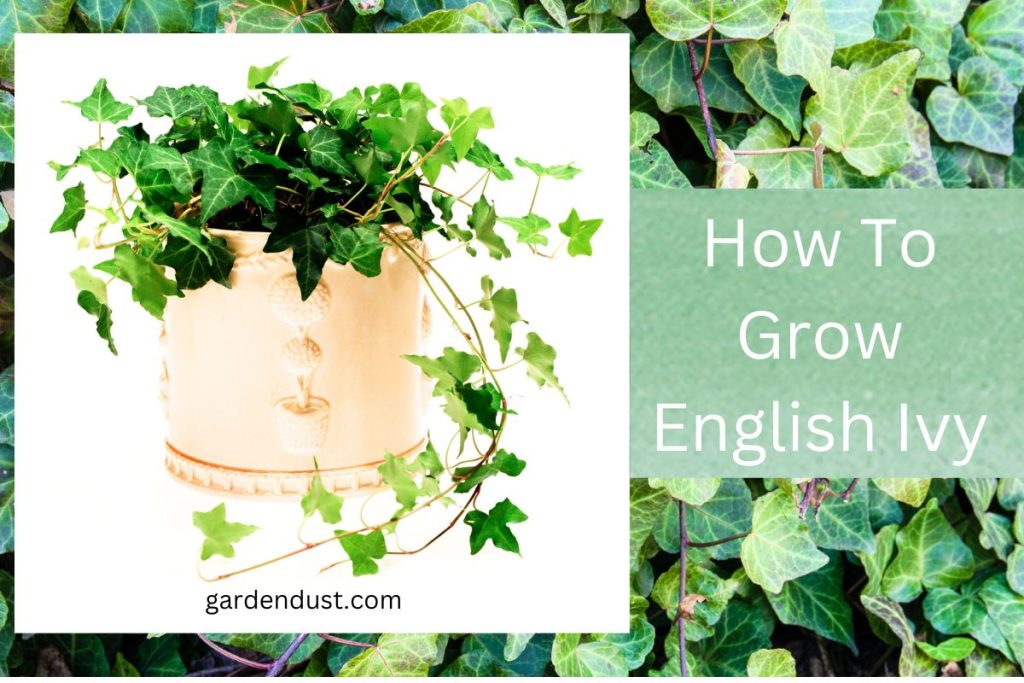English Ivy, scientifically known as Hedera helix, is a versatile and resilient evergreen vine that has adorned gardens, walls, and landscapes for centuries. Its lush, green foliage, along with its ability to thrive in various conditions, makes it a popular choice for both indoor and outdoor cultivation. Whether you’re a seasoned gardener or a beginner with a green thumb, this comprehensive guide will walk you through the step-by-step process of how to grow English ivy successfully. Let’s start…
Botanical Name: Hedera helix
Family: Araliaceae
Genus: Hedera
Plant Type: Evergreen Vine
Grow And Care For English Ivy
Choosing the Right Location
Before delving into the actual planting process, it’s crucial to select the right location for your English Ivy. This hardy plant can adapt to a variety of light conditions, but it generally prefers partial to full shade. Consider planting it in areas with dappled sunlight or indirect light. English Ivy can also tolerate low-light conditions, making it an excellent choice for indoor cultivation.
Soil Preparation
English Ivy is not overly picky about soil, but it does best in well-draining, slightly acidic to slightly alkaline soil. Prepare the soil by incorporating organic matter, such as compost or well-rotted manure, to enhance fertility and drainage. Ensure that the soil pH falls within the range of 6.0 to 7.8 for optimal growth.
READ ALSO:-How to Grow and Care for Sesame Plants
Planting English Ivy
Now that you’ve chosen the right location and prepared the soil, it’s time to plant your English Ivy. Follow these steps for a successful planting process:
- Choose Healthy Plants: Purchase healthy English Ivy plants from a reputable nursery or garden center. Look for plants with vibrant green leaves and no signs of disease or pests.
- Timing: The ideal time to plant English Ivy is in the spring or fall when the weather is mild. This allows the plant to establish its roots without the stress of extreme temperatures.
- Digging Holes: Dig holes that are slightly larger than the root balls of your plants. Space the holes about 12 to 18 inches apart to give the ivy room to spread.
- Planting Depth: Place each English Ivy plant in its respective hole at the same depth it was in the nursery container. Backfill the holes with soil and water thoroughly to settle the soil.
Establishing a Support Structure
English Ivy is a climbing vine, and providing a support structure is essential for its upward growth. Whether you’re growing it against a wall, fence, or trellis, make sure the support is sturdy and will accommodate the plant’s potential size. Attach the ivy to the structure using soft ties, allowing room for growth and expansion.
Watering Routine
Proper watering is crucial for the initial establishment and ongoing health of English Ivy. Follow these watering guidelines:
- Initial Watering: Water the newly planted English Ivy thoroughly after planting to help settle the soil and promote root establishment.
- Establishment Phase: During the first growing season, keep the soil consistently moist but not waterlogged. Water deeply whenever the top inch of soil feels dry.
- Mature Plants: Once English Ivy is established, it becomes more drought-tolerant. However, regular watering is still necessary, especially during prolonged dry spells.
Mulching
Applying a layer of organic mulch around the base of your English Ivy serves multiple purposes. Mulch helps retain soil moisture, suppress weeds, and regulate soil temperature. Spread a 2 to 3-inch layer of mulch, such as shredded bark or compost, around the base of the plants, leaving a small gap around the stems to prevent rot.
Fertilizing English Ivy
English Ivy is not particularly demanding when it comes to fertilization, but providing nutrients can encourage healthier growth. Follow these fertilizing tips:
- Slow-Release Fertilizer: Apply a balanced, slow-release fertilizer in the spring to promote steady growth throughout the growing season.
- Organic Fertilizers: Alternatively, you can use organic fertilizers like well-rotted compost or aged manure. Apply these materials in the spring and again in the fall.
Pruning and Training
Pruning is essential for shaping and controlling the growth of English Ivy. Follow these pruning and training guidelines:
- Regular Pruning: Trim the tips of the vines regularly to encourage bushier growth. This helps create a fuller, more attractive appearance.
- Remove Dead or Yellow Leaves: Remove any dead or yellowing leaves to maintain the plant’s overall health and appearance.
- Training Upward Growth: If your English Ivy is growing along a vertical support, guide the vines upward as needed. This encourages the ivy to climb and cover the designated structure.
Dealing with Pests and Diseases
English Ivy is generally resistant to pests and diseases, but occasional issues may arise. Keep an eye out for common problems:
- Pests: Aphids, spider mites, and scale insects are potential pests. Use insecticidal soap or neem oil to control infestations.
- Diseases: Root rot can occur if the soil is consistently waterlogged. Ensure proper drainage and avoid overwatering to prevent this issue.
Propagation
If you want to expand your English Ivy collection or share it with friends, propagation is a cost-effective and straightforward method. Here’s how to propagate English Ivy:
- Cuttings: Take 4 to 6-inch cuttings from healthy, mature vines. Remove the lower leaves, leaving only a few leaves at the top.
- Rooting Medium: Plant the cuttings in a well-draining rooting medium, such as perlite or vermiculite. Keep the medium consistently moist.
- Root Development: After a few weeks, roots should develop. Transplant the rooted cuttings into individual pots or directly into the garden.
Growing English Ivy can be a rewarding experience, whether you’re enhancing your outdoor landscape or bringing a touch of green indoors. By selecting the right location, providing proper care, and addressing any issues promptly, you can enjoy the lush beauty of this versatile plant. Follow the detailed steps outlined in this guide, and you’ll be well on your way to cultivating healthy and vibrant English Ivy in your garden or home. Happy Gardening…







